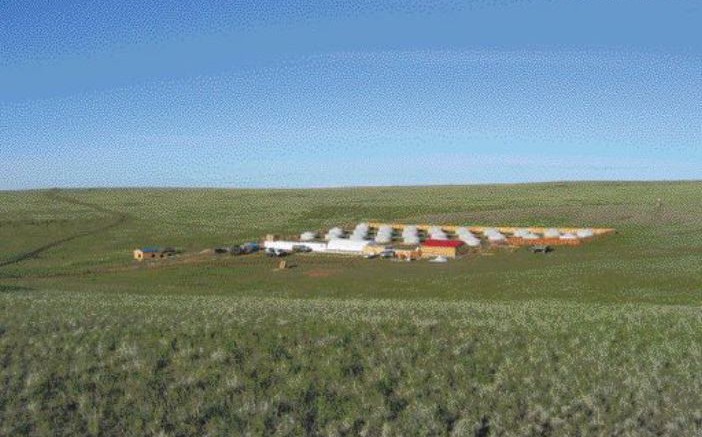Vancouver — Initial drilling by
The first three holes poked into Saddle Hill’s Gurvanbulag deposit cut significant uranium mineralization, including:
– 2.2 metres (from 186 metres down-hole) grading 0.21% U3O8 in hole 5001, which targeted the northwest up-dip portion of the deposit;
– 2.8 metres (from 252 metres down-hole) of 0.29% U3O8 in hole 5002, which was 250 metres east of hole 5001, in the Gurvanbulag zone just above the 200-metre level underground workings;
– 6.8 metres (from 310 metres down-hole) of 0.57% U3O8, including 3.3 metres at 0.98% U3O8, in hole 5003, which targeted what was thought to have been a low-grade zone at the 200-metre level.
The company experienced poor recoveries in its first two holes due to rock and drilling conditions, requiring down-hole size reductions.
Hole 3, an N-core diameter hole from surface, delivered much better recovery and was drilled to a downhole depth of over 300 metres. Better core recovery may translate into higher grades compared with the prior Russian drilling, which only averaged 50-60% recovery.
Western Prospector has drilled 15 of 100 holes planned for this year, and concedes there have been some delays in drill permitting owing to the government’s relative unfamiliarity with uranium projects.
Two rigs are now active at Saddle Hills and a third will be added soon.
In a recent conference call, Western Prospector President and CEO John Brock said his company’s $23 million in cash “fully satisfies” its plan to complete a prefeasibility study at Saddle Hill’s Gurvanbulag deposit by the end of 2006.
The company has permits to dewater the old underground workings, and could begin that work next March. It’s also building settling ponds and has sourced a head frame from
Saddle Hills covers about 1,900 sq. km in 12 contiguous exploration licences. Uranium mineralization occurs mainly as stratabound lenses in the lower part of a Mesozoic sedimentary sequence grading, stratigraphically upwards, into volcanic rock within the Saddle Hills Basin. All this overlies a late-Proterozoic to Paleozoic basement of gneisses, schist and granites.
Additional mineralization occurs as structurally controlled, near-vertical zones that may connect with the stratabound zones.
At the Gurvanbulag deposit, uranium occurs as fracture-coating yellow uranophane and black pitchblende or coffinite.
The Russian Past
Soviet geologists explored the area in the mid-1970s using geophysical surveys and drilling to discover the uranium deposits. They developed the Gurvanbulag deposits for production by excavating underground workings that included three shafts.
The main, concrete-lined, 4-compartment shaft exceeds 500 metres depth and services eight levels with extensive lateral development and stoping. (For instance, there is an estimated 10 km of workings just on the 200-metre level.)
At the Dornod deposits, both open pit mining and underground development took place.
Soviet resource calculations, conducted from 1982-89, covered the five main deposit areas: Gurvanbulag, Mardaigol, Khavar, the Dornod blocks and Ulaan.
The study tallied an aggregate resource of 4.3 million tonnes grading 0.245% U3O8 (about 23 million contained lbs. of U3O8), classified as C1 category mineralization and believed comparable to modern inferred resources.
The C1 resource is almost exclusively in Gurvanbulag.
An additional 10.7 million tonnes grading 0.14% U3O8 was classified as C2, but is not comparable to a modern resource standard without verification drilling.
None of the Russian calculations are compliant with National Instrument 43-101.
Wayne Roberts, a director and vice-president of exploration of Western Prospector, reckons that drilling 20 to 30 holes into the C1 mineralization would be enough to upgrade it to a measured and indicated resource.
On the C2 area, he thinks 40-60 holes would be needed to come up with indicated and inferred resources.
Along comes Khan
Past mining in the Saddle Hills area mostly centred on the Dornod deposits, now 58% held by up-start Canadian company
Khan recently signed a agreement with Western Prospector, whereby Khan bought a portion of an exploration licence and surface rights near its Dornod project from Western Prospector. The deal allows access to the existing production and service shafts of Dornod 7.
Between 1988-95, recorded production from the Dornod 2 open pit was just over 700,000 tonnes grading 0.12% U3O8.
In late 2004, consultants Roscoe Postle Associates calculated an inferred resource at Dornod of 4.4 million tonnes grading 0.33% U3O8 (or 31.7 million lbs. of contained U3O8) using a 0.177% U3O8 cutoff.
With the uranium spot price at US$30.20 per lb. of U3O8, both Western Prospector and Khan Resources appear poised to reap the benefits of the continued uranium rally.
A potentially significant uranium source on China’s doorstep has not gone unnoticed, and Western Prospector has acknowledged interest by senior uranium companies as well as the signing of confidentiality agreements.
Regarding Mongolia’s mining legislation, Western Prospector’s president and CEO anticipates there will be changes to the Mining Tax Act, which will be reviewed by Mongolia’s parliament early in the fall.
“We expect the current five-year, tax-free period will be reduced to accommodate payback of capital and that the current royalty of 2.5% will remain the same,” said Brock.
Ivanhoe’s discussions with the Mongolian government regarding a stability agreement for developing its Oyu Tolgoi project are expected to bear fruit before year-end. The discussions are of broad interest in the mining community, as the resolution will likely provide a framework for other mineral development projects in the country.
Western Prospector’s latest uranium drill results delighted investors, who pushed up the company’s shares almost 20% to the $3.70 level. Given its 31.3 million shares outstanding, the company posts a $116-million market capitalization.
Other significant uranium explorers now active in Mongolia include


Be the first to comment on "Saddle Hills drilling confirms U3O8 grades"